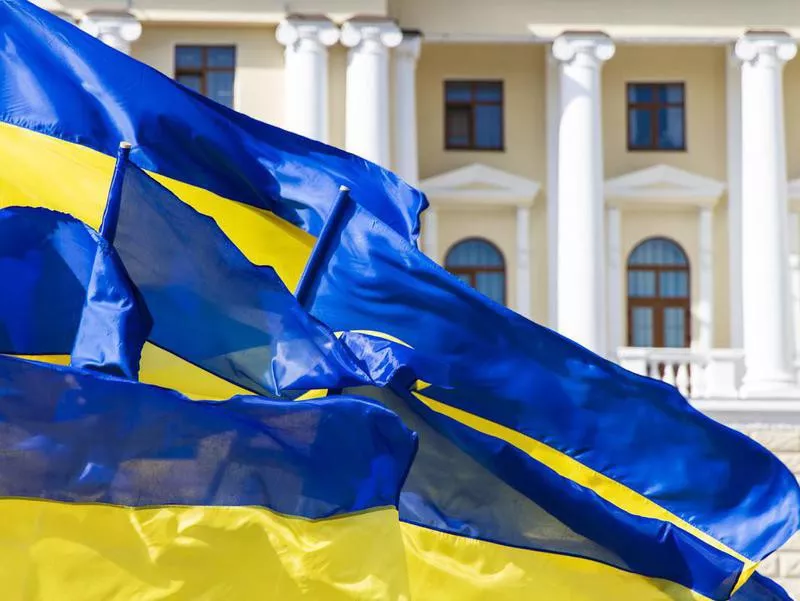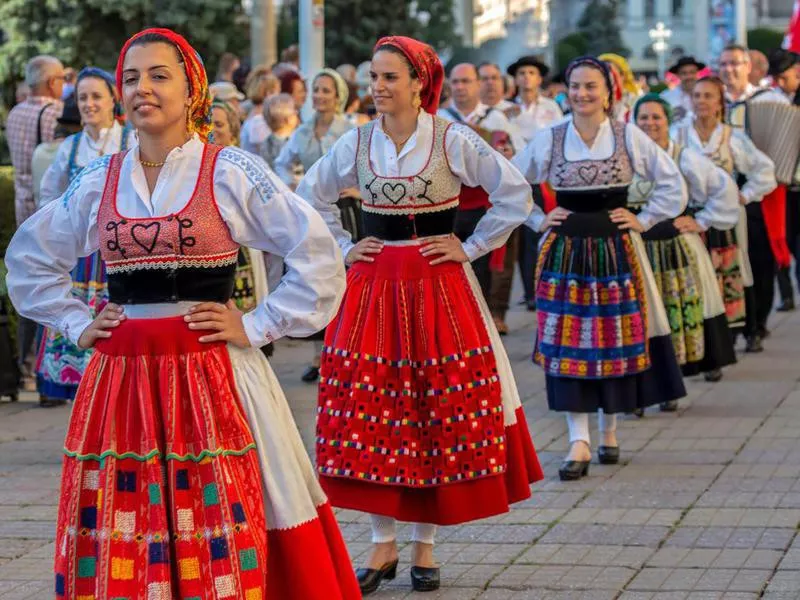Being bilingual is a good skill to have in this globalized world. It's why so many people spend time learning a second language.
The languages that countries are most interested in learning, however, aren’t always what you would expect. Today, for instance, there is more interest in Asian languages than in European languages. Where the interest is coming from is also unexpected. Why are Peruvians obsessed with Korean, and why do Fijians want to learn Hindi?
You can probably guess the most popular second language, but the rest may surprise you.
10. Zulu (Tie)

Dendenal81 / Getty Images
Country of origin: Eswatini, Lesotho, South Africa
Popular in: Malawi
Number of native speakers: 12 million
*Rankings are based on a WordTips report.
Why People Want to Learn Zulu

ManoAfrica / Getty Images
Tied with five other languages in the 10th spot, Zulu is widely spoken in southern Africa, the native home of the Zulu people. As one of South Africa’s official languages, the language has about 12 million native speakers throughout the region.
Many Zulus live in Malawi, which would explain why non-native speakers are interested in learning it. Being fluent in Zulu can facilitate commerce, trade and communication with members of the large ethnic group.
10. Ukrainian (Tie)

Artem Kniaz / Getty Images
Country of origin: Ukraine
Popular in: Ukraine
Number of native speakers: 35 million
Why People Want to Learn Ukrainian

different_nata / Getty Images
Why would Ukrainians be interested in learning Ukrainian, their own language? As a former state of the Soviet Union, there are still some Ukrainians that don’t speak the language after being forced to learn Russian as children.
These aren’t the majority of people, but it is common enough for there to be a large internal interest in the language. The interest has grown as the conflict between the two countries is ever-looming, with some politicians even calling for a ban on Russian language media.
Start learning Ukrainian today.
10. Swahili (Tie)

mtcurado / Getty Images
Country of origin: East Africa
Popular in: Tanzania
Number of native speakers: 16 million
Why People Want to Learn Swahili

ASphotowed / Getty Images
The lingua franca (link language) of East Africa, Swahili is the official language of several countries in the region: the Democratic Republic of Congo, Kenya, Tanzania and Uganda.
But in all of these countries, there are, of course, numerous other languages spoken that reflect the tribes of the territories. It would make sense, then, that people who speak their own tribal language would seek to learn Swahili as a second language.
10. Russian (Tie)

MaxOzerov / Getty Images
Country of origin: Russia
Popular in: Armenia
Number of native speakers: 155 million
Why People Want to Learn Russian

vladimirvasil / Getty Images
As with Ukraine, Armenians were forced to learn Russian when the country was part of the Soviet Union. Because of this, many older Armenians speak Russian.
Younger generations also want to learn Russian because the two countries engage in commerce. The language is advantageous for business and for traveling around the region.
10. Italian (Tie)

Stefano_Pellicciari / Getty Images
Country of origin: Italy
Popular in: Argentina
Number of native speakers: 63.4 million to 85 million
Why People Want to Learn Italian

nrqemi / Getty Images
Yes, Italian is a beautiful language, but why are Argentineans obsessed with learning it above all other languages?
After World War II, many Europeans fled to South America. Most of those who could chose to head to Argentina, which at the time was known as "the Paris of the Americas." Argentina has a strong European vibe in architecture and culture, but it is also one of the whitest, least indigenous countries in the region, which was a plus for overtly and low-key racist Europeans.
Today, about two-thirds of people in the country have Italian descent. They want to learn the language to reconnect with their roots.
10. Hindi (Tie)

Shivendu Jauhari / Getty Images
Country of origin: India
Popular in: Fiji
Number of native speakers: 342 million
Why People Want to Learn Hindi

Shimbhuistock / Getty Images
Hindi is spoken by more than 300 million people, most of whom are in northern India. It’s interesting, then, that tiny Fiji would be so keen on learning it as a second language.
The reason behind this interest goes back to the late 19th century, when the British Empire brought around 60,000 enslaved people from India to Fiji. (Keep in mind, slavery was supposedly abolished in the British Empire in 1807.)
Many of the descendants of these slaves still reside in the island nation and speak Fiji Hindi. Learning standard Hindi is popular in this community.
7. Portuguese (Tie)

Caroline Brundle Bugge / Getty Images
Country of origin: Portugal
Popular in: Paraguay, Sweden
Number of native speakers: 200 million
Why People Want to Learn Portuguese

florin1961 / Getty Images
Paraguayan people predominantly speak Guarani, then Spanish. Because the country borders the giant powerhouse that is Brazil, many also make the effort to learn Portuguese.
It seems like Sweden’s reason for learning Portuguese is more simple: Swedish people like vacationing and retiring in Portugal.
Most learn English from childhood, so Portuguese is most likely a third language, but it is the language they actively choose to learn.
Start learning Portuguese today.
7. German (Tie)

vm / Getty Images
Country of origin: Germany
Popular in: Denmark, Slovenia
Number of native speakers: 95 million
Why People Want to Learn German

mcbrugg / Getty Images
Denmark shares its only land border with Germany, so it makes sense that Danish people would want to learn German.
In Slovenia’s case, the history is a bit more interesting. Bavarian communities existed in what is now Slovenia since the eighth century, and the language had a strong presence until World War II. After the war, many Germans were expelled or murdered and the numbers of native speakers in the country dropped significantly.
Still, the small communities of people with German descent continue to be interested in learning to speak the language.
7. Chinese (Tie)

golero / Getty Images
Country of origin: China
Popular in: Belize, Laos
Number of native speakers: 918 million
Why People Want to Learn Chinese

P_Wei / Getty Images
It’s somewhat surprising that Mandarin Chinese doesn't rank higher, given how everyone’s predicted it will soon replace English as the global lingua franca. Only two countries chose Mandarin over every other language to learn.
For Laos, the choice is obvious, given its border with China and the commercial opportunities speaking the language presents. But why Belize? A tiny, English-speaking country in Central America. The reason goes back to the 19th century, when Chinese immigrants were brought as indentured servants and slaves to work in sugarcane plantations. There have also been more recent migrations from China and Taiwan.
These communities hold on to their language as a way to keep their culture.
Start learning Mandarin Chinese today.
6. French

querbeet / Getty Images
Country of origin: France
Popular in: Algeria, Botswana, Kenya, Morocco, Zambia
Number of native speakers: 80 million
Why People Want to Learn French

AlexKozlov / Getty Images
French was once the lingua franca of the world, but it seems like now it is mostly sought after by its former colonies and other African countries. In Algeria and Morocco, many people still learn French as a second language in school, and it is still a widely used language for tourism.
The rest of the African nations that are interested in French are Botswana, Kenya and Zambia. This may be because many people in these countries already speak English and French can open up communication with other countries.
5. Korean

Nate Hovee / Getty Images
Country of origin: North Korea, South Korea
Popular in: Brunei, Chile, Nepal, Peru, Philippines, Singapore
Number of native speakers: 75 million
Why People Want to Learn Korean

NeoPhoto / Getty Images
The Korean peninsula is fairly small, yet the popularity of Korean has risen in recent years. The language is sought after in nearby countries like Brunei, Nepal, the Philippines and Singapore. This is probably for economic and business reasons, given South Korea’s strong economy.
But there’s another reason the language is taking the world by storm: K-pop. The music genre has found a large fandom outside of South Korea, with boy band BTS breaking numerous Guinness World Records, including most streamed group on Spotify.
4. Japanese

Yoshitaka Naoi / Getty Images
Country of origin: Japan
Popular in: Australia, Bhutan, Canada, Hong Kong, New Zealand, South Korea, Taiwan, United States
Number of native speakers: 126 million
Why People Want to Learn Japanese

ablokhin / Getty Images
The most popular Asian language to learn comes from the small island nation of Japan. The language is particularly popular in English-speaking countries, probably because of the prevalence of manga and anime culture.
For Bhutan, Hong Kong and South Korea, it may be part cultural fascination, part business savviness.
Start learning Japanese today.
3. Arabic

LordHenriVoton / Getty Images
Country of origin: Iraq or Yemen
Popular in: Bahrain, Egypt, Jordan, Kuwait, Lebanon, Maldives, Niger, Oman, Palestine, Qatar, Saudi Arabia, United Arab Emirates
Number of native speakers: 274 million
Why People Want to Learn Arabic

Diy13 / Getty Images
What’s particularly interesting about Arabic is that all the countries where people want to learn it are already Arabic-speaking. In the case of Niger, the tendency probably comes from people who learn a tribal language first and then want to learn French and Arabic, the country’s two official languages.
For the other countries, the interest in the language may come from the large number of immigrant workers who go to the Arabian peninsula. These foreign employees would seek to learn the language to better move around their new homes or to get better job opportunities.
2. Spanish

GoranQ / Getty Images
Country of origin: Spain
Popular in: Andorra, Antigua and Barbuda, Costa Rica, Czechia, Dominican Republic, Guatemala, Honduras, Nicaragua, Panama, Saint Vincent and the Grenadines, Spain, Trinidad and Tobago, United Kingdom, Uruguay
Number of native speakers: 460 million
Why People Want to Learn Spanish

leonovo / Getty Images
A total of 20 countries have Spanish as their official language, courtesy of the Spanish empire’s global colonialism. Much of the interest for learning Spanish comes from some of these countries.
In places like Guatemala, this is in part due to the large indigenous populations that continue to learn Spanish as a second language. The other explanation is the large number of immigrants and retirees that go to Latin America or Spain.
Costa Rica and Panama particularly stand out as a place where there are large concentrations of European and American immigrants.
1. English

oversnap / Getty Images
Country of origin: England
Popular in: 98 countries
Number of native speakers: 527 million
Why People Want to Learn English

oversnap / Getty Images
We don’t imagine anyone can be surprised by English placing first. But it is astonishing to realize the interest is coming from 98 countries. This is more than the countries interested in all other languages combined.
Most people want to learn English for practical purposes, given that knowing the language can open up employment opportunities and make it easier to travel around the world.
